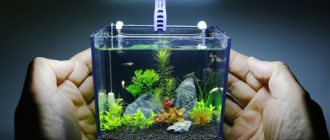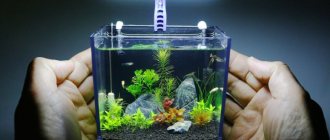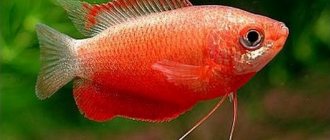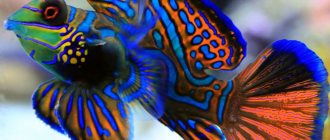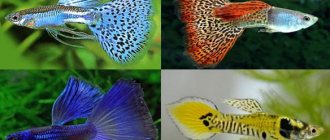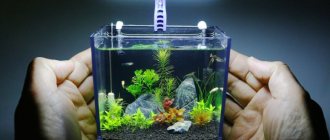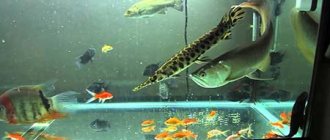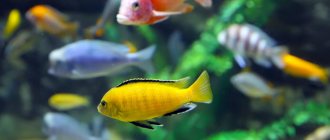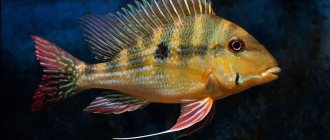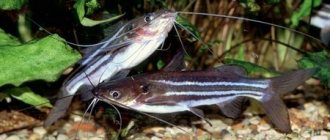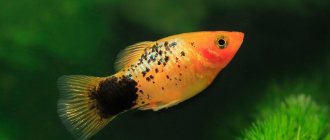11/14/2021 9,176 Aquarium fish
Author: Olga
Mollies are a group of fish that are very popular among aquarists for their ease of breeding and peaceful nature. The popularity of molly has given rise to a large number of experiments on its appearance. From wild forms of discreet colors, gorgeous individuals of bright colors were bred, and the fins of some individuals turned into a real work of art. One of the beautiful variations is the yellow aquarium molly, and it is its content that we will talk about today.
[Hide]
Description
Mollies belong to the genus of viviparous fish, which means that they do not lay their eggs in a safe place, but the eggs and fry develop inside them until they are ready for the outside world. The black fish called Black Molly was first artificially bred in 1909. It was then that the species from the Poeciliaceae family became widespread.
The range is wide, yellow mollies are able to adapt to new environmental conditions, so they have mastered fresh and brackish water bodies. But the largest concentration of fish is found in central and northern America and in the vicinity of the Yucatan Peninsula.
In their natural environment, mollies are not so brightly colored; the more common coloring is gray with faint tints of yellow and green with camouflage spots. But breeders received a fish with a rich yellow color, sometimes with an orange or green tint. Often small orange spots are visible on the fins and head. A closely related color is the black and gold molly, half of the body of which is painted black.
The length does not exceed 10 cm in an aquarium. The body shape is widened in the center and greatly tapered in the tail and head. The fins are transparent, sometimes spotted. Particularly prized are individuals with a tail that has extensions at the ends. They are called lyretail golden mollies.
View this post on Instagram
#aquarium#aquariumfish#aquariumscience#underwaterworld#all_the_most_interesting #interestingfacts#poeciliaceae#family_petsilii #molliesia #mollies #mollies_yellow #mollies_yellow #mollies_golden #mollies_male_and_female
A post shared by Home Aquarium (@rubka_life_) on Aug 30, 2017 at 2:53pm PDT
The order Poeciliidae includes, in addition to the golden one, 30 more species of mollies.
The most common ones are:
- Molly peten. The most famous color of this mollies is gold and black. A distinctive feature is that there is a red stripe on the fins, which clearly distinguishes them from other fish.
- Broad-finned. It is distinguished by its large size - up to 20 cm. Body color ranges from blue to orange.
- Sphenops or coal. Molly, common among aquarists for more than 8 decades. The size is no more than 7 cm. The body seems to be flattened, the fins are smooth and rounded.
- Balloon. The Latipine subspecies is distinguished by a short, seemingly crooked body and a plump, strongly protruding abdomen. The fins against the background of a medium-sized body look more aesthetically pleasing than on other species.
- Small-finned. This species has reduced fins, especially the dorsal one. The body is elongated, without a protruding belly. The most common colors are blue, gray, brown, silver.
Lifespan
The average lifespan of mollies in an aquarium with proper maintenance ranges from 4 to 5 years. But monotonous feeding, untimely cleaning of the aquarium, and overcrowding of the tank significantly shorten the lifespan of the fish to 2 years. Females usually live longer.
Mollies habitat
Habitat is Central America, the southeastern part of the USA, eastern and northern South America. Thanks to their unpretentiousness and endurance, they managed to populate such vast territories with different conditions. They live not only in bodies of fresh water, but also in estuaries - places where rivers meet the oceans, where the water has a high level of salinity.
Different types of mollies prefer different regions. Thus, the sphenops molly (lat. Poecilia sphenops) can be found in large numbers in reservoirs from Colombia to Mexico, and the velifera molly (lat. Poecilia velifera) lives on the Mexican Yucatan Peninsula. Southern states of the USA, in places where the water has increased salinity, mollies latipin.
In modern conditions, fish are grown en masse on farms, especially common in Southeast Asia. And from there they go all over the world to delight aquarists.
Maintenance and care
Caring for mollies mainly involves maintaining clean water and parameters for comfortable life of the fish. The inhabitants are less picky about other conditions, so they are suitable as a first pet for a novice aquarist.
Weekly water changes in the amount of ¼ of the aquarium volume. It is necessary to siphon the soil depending on the degree of contamination and the number of inhabitants, but usually cleaning is carried out once every couple of months. A complete cleaning of the aquarium is required once a year.
It is not necessary to keep fish in a school, but it is advisable. Wide opportunities open up in the combination of neighbors due to the peaceful and non-aggressive nature of yellow mollies.
Aquarium
Although the fish are considered unpretentious, they cannot be kept in cramped and crowded aquariums. There should be more than 10 liters of water per fish. In close quarters, unusual traits appear for them - aggressiveness and hostility towards everyone around them.
Water parameters
- The temperature is not lower than 24 and not higher than 28 degrees.
- Water hardness is from 22 to 28 dGH.
- Water acidity is from 7.0 to 7.9 pH.
- The salinity of the water is no more than a teaspoon per 10-liter aquarium.
Plants
Yellow fish are shy by nature, so they need dark, secret hiding places in which they feel safe. The role of shelters is performed by plants with dense foliage. Therefore, plant in the aquarium:
- Alternanter.
- Aponogeton.
- Barclaya longifolia.
- Vallisneria.
- Hygrophila.
- Brazilian pinnate.
- Echinodorus.
- Lagarosiphon curly.
Equipment
To keep the aquarium clean and free of fish waste, install a filter in the tank. A condenser will help enrich the water with oxygen.
Lighting
Fish in their natural environment live among reservoirs with a lot of sunlight, so provide 12-hour lighting in the aquarium. In summer, for lighting, it is enough to place the aquarium next to the window (but without direct sunlight). In winter, the missing light is compensated with additional lighting.
Priming
For mollies, the substrate for the bottom does not matter, but river sand or crushed pebbles are more often chosen.
Mollies are hardy and unpretentious aquarium fish
Mollies (lat. Mollienesia): black, snowflake, velifera, sphenops, latipine - whatever of these species you name, they are all popular and widespread in the aquarium and belong to the same species, although sometimes they look very different. And all because they have many advantages - they are peaceful, very hardy and unpretentious, inexpensive, and they simply reproduce. These are purely American fish, as they live in North and South America. Wild species can be divided into two groups: those with short fins, such as the black molly, and those with long fins, such as the molly velifera or marble molly.
Most species appeared in aquariums back in 1899, and various hybrids since 1920. Now you can find black aquarium mollies, snowflakes (completely white or yellow), silver ones, and spotted ones. And the number of different species continues to grow and gain popularity.
For beginner aquarists, the best choice is the common black aquarium molly, as it is less demanding, easier to breed and requires smaller aquariums. To maintain all types, you need a well-planted aquarium that is quite spacious. It is important that their diet contains a lot of plant matter and algae.
HABITAT IN NATURE
Mollies mainly inhabit coastal areas of North and South America, but are also found where rivers flow into the ocean, in brackish water. The entire continent can be called their homeland, they are so widespread.
- Types of mollies:
- Black molly or Sphenops (Poecilia sphenops) lives from Mexico to the northern states of the United States.
- The latipin moth (Poecilia latipinna) is found along the southeastern coast of the United States and in Mexico.
- Velifera (Poecilia velifera) or high-finned (sailfin) molly is native to the coastal regions of Yucatan and Mexico.
All of them are distinguished by their wide range, unpretentiousness and omnivorousness, which makes them very common in these areas.
DESCRIPTION
The black molly is one of the species artificially bred in 1930; it reaches sizes of 6-10 cm in an aquarium, and up to 20 cm in nature. Life expectancy is about 3 years, but may be longer. The black molly has a completely black body, with a deep velvety hue. Often there are forms with a lyre-shaped tail fin, the black lyre.
Latipina grows up to 10 cm in an aquarium, and up to 20 cm in nature. The body color is silvery-brown, with dark and blue dots. A distinctive feature is the high dorsal fin. Velifera in general is very similar to Latipina, but now it has received a new and popular look - from it a completely white species has been bred - snowflake.
Popular types
Here are the most popular types of mollies: black mollies (lyra-molly), Velifera sailcloth mollies, sailed mollies. Silver mollies (also called snowflake mollies) are a breeding form of sailcloth mollies.
It is better to keep them in groups or pairs.
This fish lives mainly in the upper and middle layers of water and loves water space and light.
The daylight hours of mollies should be at least 12-13 hours. It is useful for fish if the lighting is natural for at least a couple of hours a day, but if this is not possible, then you can do without it.
Of course, it also needs natural shelters: thickets of plants, snags, decorative ornaments that can serve as a refuge.
Mollies feed on all types of dry and live food.
The only condition that helps keep these fish active and healthy is that they definitely need plant fiber.
Therefore, along with others, use vegetarian food, plant plants with soft leaves in the aquarium that the fish can eat. You can also feed them small portions of chopped boiled vegetables.
Another important point in keeping mollies: in their homeland they live where river water mixes with sea water, and therefore they love hard water. If your indoor pond contains only mollies and platies, you can even add a little salt to the water on purpose. If other fish live with them, then, of course, you shouldn’t do this. But in case of illness or quarantine, the fish can be placed in an aquarium with salted water - this way it will return to normal faster
Mollies sphenops (Poecilia sphenops) . Synonyms: Lyra mollies, Black mollies . Homeland: Central America, from Mexico to Colombia. Black molly , as it is often called popularly, is the most common type of mollies with a classic black color. There may be different variations of shades from olive-brown to green and blue scales. black mollies can “regenerate” - change their sex, both at a young and mature age.
Orange mollies. One of the most attractive color forms of Mollies sphenops. Unpretentious, flexible, quickly adapts to new conditions. It gets along well with other viviparous and other fish, which are characterized by peacefulness or, at least, the absence of pronounced aggressiveness. Feels best in a densely planted container. Prefers fairly bright, but diffused light (the optimal filter is vegetation floating on the surface). It looks most advantageous against the backdrop of dark soil and the bright greenery of an underwater garden. When there is a shortage of vegetarian food, it can eat tender young shoots. It lives mainly in the middle layers of water. Maximum size - 12 cm. Approximate size - 3.5 cm.
Optimal maintenance conditions: T = 23-280C, dGH 10-300, pH 7-8.5, salinity up to 8%, filtration, aeration and regular replacement of fresh water (up to 30% per week) are required. The minimum volume of the aquarium is 50-70 liters per couple.
Food: frozen and dry food from well-known manufacturers, including those with plant ingredients. Prone to gluttony, it is necessary to arrange a fasting day. To enhance color, it is advisable to include feed rich in carotenoids in the diet.
Silver spotted molly or Dalmatian molly (Poecilia sphenops var.) . The upper size limit is 6 cm.
Silver molly “Snowflake” (Poecilia sphenops var.) - this breeding form of sailing molly, which appeared in the mid-90s, quickly gained popularity due to its exceptionally delicate and unique coloring - almost white with a slight bluish tint. Unpretentious, gets along with reasonable neighbors. Prefers an aquarium with dense vegetation, in which it willingly hides from overly annoying neighbors. The maximum size is 10-14 cm. The upper limit of the size is 5 cm.
Optimal maintenance conditions: T = 22-280C, dGH 8-250, pH 7-8.5, salinity - up to 5%, filtration, aeration and regular replacement of fresh water are necessary. The minimum volume of the aquarium is 60-80 liters per couple, but they feel better as part of a school with a predominance of females in a spacious (200-400 liters) tank.
Food: frozen and dry food from well-known manufacturers, including those with plant ingredients. Prone to gluttony, it is necessary to arrange a fasting day.
Broad-finned molly , or Latipin molly (Poecilia latipinna) . Homeland: Southeast and Southwest America, from Carolina to Southern Mexico. Swallowtail mollies - males have a greenish-brown body according to the gods with a white and bluish tint under the throat and belly. You can often see drops and dots on the sides - red, green or blue - and there may also be black spots in the abdomen area. The dorsal fins are blue, often with a dotted pattern of blue, black or orange (depending on body color). The color of the female is almost no different from the male. It should only be noted that females are always slightly paler than males.
Mollies Balloon (Poecilia Balloon) . A selection form of the broad-fin molly. Prefers an aquarium with dense vegetation (including floating) and plenty of free space for swimming. When there is a shortage of vegetarian food, it can eat tender young shoots. It lives mainly in the middle layers of water. There are color and veil forms. Approximate size: 2.5 cm. Maximum size: 12 cm.
Optimal maintenance conditions: T = 20-280C, dGH 10-250, pH 7-8.5, if necessary - salinity up to 8%, filtration, aeration and regular replacement of fresh water (up to 30% per week) are necessary.
Food: frozen and dry food from well-known manufacturers, including those with plant ingredients. Prone to gluttony, it is necessary to arrange a fasting day. The minimum volume of the aquarium is 50-70 liters per couple.
Mollies Velifera , or Sail mollies (Poecilia velifera) . Homeland - Southern Mexico. Velifera is one of the most beautiful species of mollies. The body of this fish can be from green-blue to silver. The body may have various dot patterns of the same but more saturated colors. The dorsal and anal fins are transparent and have beautiful pearlescent inclusions.
Care and maintenance
The minimum size of an aquarium for keeping mollies is 30 liters; when choosing an aquarium for these fish, you need to take into account that a pair of adult fish should have at least 6 liters of liquid. It is desirable to create a stable biological balance of the environment in the aquarium. All types of mollies are quite thermophilic and prefer water with a temperature of 22-30 ° C and do not tolerate temperature changes well.
Fish love fresh water, so a systematic, for example once a week, partial replacement of about 25% of the volume of water with fresh and settled water is desirable. When doing a water change, you need to strictly monitor the temperature. Biological filtration and intensive aeration of water are required, recommended acidity pH is from 7.2 to 8.5, hardness dH is in the range of 10 - 35°. It is not recommended to lower water hardness below the minimum. Most of the time, the fish stay in the upper and middle layers of the aquarium. Mollies are very fond of bright sunlight or artificial lighting of the aquarium, with an intensity of about 0.5 - 0.7 W per liter. Optimal daylight hours for these fish should last at least 12 hours, so it is necessary to equip the aquarium with open, well-lit areas. No less important is the presence of snags, hills of stones for shelter and dense thickets of aquarium vegetation.
Mollies are an active fish, moderately friendly. It is better to keep her in a group with a predominance of females. It can live both in a general aquarium and in a separate one. It gets along well with a variety of neighbors, but it is advisable not to keep tiger barbs together, as they can conflict. In general, neighboring fish should be approximately the same size. Mollies get along well with each other, but in a cramped aquarium, males can chase each other. Therefore, it is better to provide a spacious aquarium so that there is at least 10 liters of water per individual. Medium-sized gravel is suitable as a soil.
These fish are omnivores, but a varied diet is important for them. They can eat live, frozen, dry and plant foods. But under no circumstances should you feed them only animal food. Plant food for mollies, especially fry, is very important. They can even eat algal growth on the walls of the aquarium or plaque on plants. But if there is a lack of plant food, they can begin to eat young shoots of plants.
If there is not enough oxygen in the water, the behavior of the fish changes: the mollies swim a lot at the surface of the water, signaling the owner about problems in the aquarium. When the water spoils or the temperature drops, mollies move weakly and press their fins to their body; sometimes they can lie on the bottom or sway in one place. This situation can be corrected by increasing the temperature to the optimal value and replacing a third of the water with settled fresh water. Adding sea or regular table salt to water in a ratio of 2 - 3 g per liter of water works well.
REPRODUCTION
Sexual differences between males and females
Female Mollies are much larger than males. By this feature it is very easy to distinguish them from each other. In addition, all males have a rolled-up anal fin, while females have a triangular fin.
Breeding recommendations
In a fish like mollies, reproduction is very simple. Since all platies are viviparous, fry are born immediately, bypassing the egg stage. The female becomes sexually mature at 5–7 months, while in males development takes from 9 to 12 months. In order for a pair of mollies to mate, there must be warm salt water in the aquarium. Table or sea salt should be added at the rate of 1 spoon per 20 liters of water. The male fertilizes all the eggs available to the female at once.
Soon after this, signs appear indicating that the female is pregnant. Her abdomen increases in size, and a black spot appears in the lower abdomen. A pregnant female carries the first batch of fry for 33–45 days. When the due date begins to approach birth, the fish should be placed in a separate aquarium. Here she will give birth to about 45–55 fry at a time. After delivery, the mother should be placed back and monitored. It is possible that she will begin to bear the next batch of fry. A pregnant molly should eat better than other fish.
Her daily diet is increased and enriched with vitamins and microelements. Males selected for fertilization should also be fed with useful substances. During the period of reproduction and breeding, caring for fish becomes somewhat more complicated. You need to be prepared for this.
Getting offspring
At the end of their term, pregnant females move to a nursery where they spawn. The fry are weak and need extra care. Caring for them involves changing the water frequently. Small fish are very sensitive to any pollution. In addition, they can die in a cramped aquarium. ADVICE! To improve the immunity of babies, it is recommended to add table salt to the water. If the water temperature rises above 28°, the pregnant female will give birth to dead or premature offspring. You can feed your babies right away using special food, cyclops, Artemia nauplii, or powdered dry food. Grown-up fish are transplanted into a common aquarium.
Caring for fry
A successfully fertilized female bearing fry is distinguished by a dark spot on the lower abdomen, near the anal fin, and a large belly. The duration of pregnancy in mollies is about four weeks, after which the female gives birth to up to 100 fry; with age and growth, large mollies can give birth to up to 250 fry.
There is no need to create special spawning grounds for black mollies, because... they do not pursue their offspring.
After giving birth, the female remains a little fat because she does not give birth to all her fry at one time, but continues to carry fertilized eggs. Thanks to this, the female can bear offspring for 6 months without the participation of a male.
The most successful breeding occurs in an aquarium with various types of mollies. The fry are born quite large. For their rapid growth, you need to use plant and live food of the appropriate size; you can feed them with dry food, ground or crushed into dust. To obtain dust, simply place a certain amount of feed in a mortar and grind thoroughly. Special food for fry is available in pet stores. You need to feed often and plentifully.
It is important to know
Breeding molly in a general or separate aquarium is not difficult, but you should know some of the behavior and maintenance of both breeders and fry.
- Larger and more mature females give birth to more fry than young ones.
- The fry of mollies are large, but with a weak body, unlike the fry of guppies and swordtails. They swim to the surface of the water after a few days, and in the first days of life they lie in the aquarium at the very bottom, sometimes on the leaves of plants.
- Molly fry require frequent changes of aquarium water to avoid dying.
- Salted water (1 teaspoon per 20 liters) improves their immunity.
- If the conditions of the aquarium are not up to standard, the breeders will not give birth to healthy offspring, or will not reproduce at all. In the worst case, the female gives birth to dead fish or premature eggs.
- The reason for unsuccessful spawning may be a cramped tank, very high water temperature (over 28 degrees Celsius).
- The main food for fry is ground plant food, Artemia naupilia, Cyclops, live dust (crushed).
- After the fry grow up, they are placed in “different-sex” aquariums. Female molly fish are larger than males; males have a cone-shaped anal fin called a genopodia. Females have a rounded anal fin.
- Black mollies sometimes give birth to fry with green or blue spots on their bodies. There is nothing wrong with this - mollies from the wild have a uniform and brighter body color, so such “marks” are a sign that all hybrid mollies are descendants of natural Latin American species.
Characteristics
Aquarium species of mollies are the result of domestication of North American species, or their selection. Despite a number of differences, all fish have common qualities.
- Females of all types of mollies are an order of magnitude larger than males: for example, the velifera mollies reaches 18 cm in length, the female latipina – 12 cm, sphenops – 8 cm. Sexual dimorphism is pronounced: in addition to the difference in body size, the male’s anal fin is cone-shaped (genopod), in females it is fan-shaped. All female mollies are viviparous fish; they bear fry, bringing them into the world ready for full life activity.
- Pet stores sell various sphenops and latipinas; only experienced ichthyologists know how many of them have actually been bred. Black mollies are common on sale. Sometimes among their brood there are other forms - spotted, with light scales, or blue-green skin. New species are the fork mollies, which have a “cut out” caudal fin, elongated at the top and bottom; scarf molly, which has a long and elongated dorsal fin.
FEEDING MOLLINESIA
What to feed mollies? Omnivorous fish that eat all types of live, frozen or artificial food. But, they need a very large amount of food with plant fiber, such as algae or vegetables. The fact is that in nature, mollies have a lot of algae and various fouling in their diet, this is evidenced by their lips and behavior. You can often see them scraping off fouling from glass and decor in an aquarium.
The easiest way to feed molly is flakes with spriulina, or pieces of slightly boiled cucumbers, zucchini, and lettuce. Animals include bloodworms, tubifex, and brine shrimp. In general, there are no problems with feeding mollies, the main thing to remember is that plant food is very important for them.
Main types of feed.
NovoBel from JBL. A nutritional complex that is well balanced. It includes many components necessary for fish. Fully meets all the body needs of aquatic inhabitants. NovoColor from JBL. The fatty acids, carotenoids and natural components included in the composition improve the color of fish scales. Vipagran by sera. The main food for inhabitants of the middle layers of water.
Available in the form of small granules, it contains a complex of plants, vitamins, proteins and many other valuable substances. MInBaby by TETRA. Nutritious balanced food for fry. It contains all the useful compounds and elements that kids need. MENU by TETRA. Long-lasting food in the form of flakes in 4 different colors. Red ones improve the fertility of females and males, chestnut ones strengthen the immune system, yellow ones promote full growth, and green ones increase the lifespan of fish. This food greatly simplifies the care and maintenance of platies.
Compatibility
Mollies are considered one of the most beautiful fish, which is why they are desirable pets for many aquarists. They get along well with swordtails. Although the “swords” have a rather restless character, they chase platies very rarely.
Only if there are no female swordtails in the flock, the “guys” will try to pester the molly, but, as you understand, to no avail. Also keep in mind that in tight spaces there may be turf battles, so the fish should have plenty of space.
The compatibility of mollies with guppies is almost ideal. Both species are viviparous, live in warm, brackish water, love sunlight and dense vegetation. If your plans include breeding, then before giving birth the fish should be separated from each other, and after the offspring appear, the females should be removed, since they sometimes do not mind eating their own fry.
In general, mollies can be kept together with:
- All types of poeciliids and catfish,
- Rainbows,
- Tetrami,
- gourami,
- Labeo.
Mollies diseases
Unfortunately, gentle mollies are susceptible to a number of different diseases. All of them are the result of incorrect content. You can distinguish a sick fish by its unusual behavior: lethargic or, conversely, restless.
Gas embolism.
Develops when there is an excess of oxygen in water. Most often this happens if you pour unsettled water straight from the tap into the aquarium. The disease is manifested by restlessness and darkening of the gills. Care and treatment in this case consists of replacing the water with a more suitable one.
Melanosis.
The body becomes covered with spots of non-standard colors, which subsequently turn into tumors. This problem cannot be cured. Prevention lies in creating the right conditions of detention.
Cold.
If the fish become lethargic and apathetic, swim near the surface, and lose their appetite, it means they have a cold. The disease occurs if the water in the aquarium is too cold for mollies. Care and treatment in this case consists of creating the optimal temperature of the habitat. Life expectancy depends on the type of mollies. The average lifespan is from 4 to 8 years. Females live slightly longer than males. Balloon mollies can live no more than 2–3 years.
average price
The cost of the fish depends on the type. Regular mollies can be purchased for 45–60 rubles. Mollies of such species as snowflake, dalmatian, balloon are sold more expensively, their price is from 100 rubles.
MOLLINESIA SPHENOPS OR BLACK MOLLINESIA (MOLLINESIA SPHENOPS, POECILIA SPHENOPS)
MOLLIENESIA LATIPINNA, POECILIA LATIPINNA
PECILIIA: CARE, CONTENTS, PHOTO, VIDEO, REPRODUCE, DESCRIPTION, COMPATIBILITY
KOI CARP: DESCRIPTION, CONTENT, FEEDING, BREEDING, COMPATIBILITY, PHOTO, VIDEO.
PECILIIA: CARE, CONTENTS, PHOTO, VIDEO, REPRODUCE, DESCRIPTION, COMPATIBILITY
ZANIO: CARE, MAINTENANCE, NESTING, COMPATIBILITY, PHOTO AND VIDEO, DESCRIPTION
150 DIFFERENT KINDS OF AQUARIUM FISH
TERNETIA CARAMEL: CARE AND MAINTENANCE IN THE AQUARIUM, PHOTO
PECILIIA MICKEY MOUSE: CONTENT IN THE AQUARIUM, PHOTO
PECILIIA HAWAIIAN: CONTENT IN THE AQUARIUM, PHOTO
PECILIA RADISH: CONTENT IN THE AQUARIUM, PHOTO
HOMALOPTERA CONFUSON: CONTENT IN THE AQUARIUM, PHOTO
BOTIA PULCHRA: CONTENT IN THE AQUARIUM, PHOTO
ACANTHOCOBIS UROPHTHALMUS: CARE AND MAINTENANCE, PHOTO
Feeding
They are unpretentious when feeding and will eat any food offered. But this implies the possibility of overeating, so carefully monitor the amount of food given and if the fish are obese, reduce the portions. Feeds on live, dry and frozen food. Feeding them alive with bloodworms, earthworms, and daphnia is suitable. vipagran sera can become the basis of fish food.
Plant foods are also important in the diet. It includes lettuce, cucumbers, dandelion leaves, and apples.
Yellow mollies eat mud from the walls of the aquarium and some types of algae, keeping the tank clean.
Appearance and features
Photo: What a lyrebird looks like
The body length of an adult lyre bird is usually 76-100 cm, weight - 870-1200 g. Their sexual dimorphism is quite pronounced: males are much larger than females both in length and weight, moreover, the most characteristic feature of birds is - only males have a luxurious long lyre-shaped tail.
The birds' feathers on the back and wings are predominantly brown (with the exception of the outer pair of tail feathers), the neck and breast are gray, and the belly is beige-cream. The wings of the lyrebird are short, rounded, with beige-cream colored plumage (as on the abdomen), completely unsuitable for long flight. In their natural habitat, birds run more than fly, because they have long, strong legs. All four toes have strong, sharp claws.
The outer pair of tail tail feathers of the lyre bird are curved outward on the sides of the tail, which, in fact, reminds everyone of a lyre. The birds' eyes are round, quite large for a small head, blue or brown in color with dark brown or black pupils. The beak is medium-sized, pointed, very strong, allowing it to obtain food from hard-to-reach places. In nature, lyrebirds live up to 15 years, and in captivity they can live 2-3 times longer.
Editor's note: Crucian carp have learned to ferment sugar into alcohol
Compatibility
Mollies in many sources about fish compatibility are indicated as a species that gets along with all its neighbors, excluding predators and aggressors. The fish are peaceful in nature and treat the other inhabitants of the aquarium neutrally, without showing aggression. Get along together: gouramis, catfish, ancistrus, neons, rhodostromus, thornets, platies.
But sometimes mollies bite the fins of other fish, most often angelfish. But the fish themselves are attacked and bitten by other species: barbs, guppies, swordtails, veiltails, telescopes. A hierarchy is built among predators, and peaceful, medium-sized fish occupy the lowest places in it. Therefore, life in such a neighborhood will cost the mollies health, nerves, or even life. Do not keep with cichlids, clarius, snakeheads, tetradons.
Diseases
Diseases of mollies can be invasive and infectious; non-contagious deterioration in health is often provoked by violations of maintenance rules. When the water temperature drops below 20˚C for a day or more, fish often catch a cold. They lose their appetite and become lethargic.
Gas embolism - occurs with strong aeration or the addition of a large volume of chlorinated tap water. Causes poor circulation, darkening of the gill covers, and bruising. Without taking immediate action, the fish will die.
Invasive diseases are caused by unicellular and multicellular parasites. The fish behaves restlessly and a white coating appears on its body. The sick animal is isolated and Bicillin-5 is added to the water.
Molly breathes heavily, rises to the surface for air when there is a lack of oxygen,
Infectious pathologies:
- Fin rot is a common fungal disease caused by poor quality care and mechanical damage. The fins become deformed, tear, and decrease in size.
- White-skinned - the body turns pale, the eyes turn white, the fins curl up. The pathogen is introduced into the aquarium with plants or new pets. The sick fish is removed and Levomycetin is added to the water.
- Mycobacteriosis - mollies refuse to feed, ulcers and scabs appear on the body, and their eyes bulge. The sick animal is isolated and the aquarium is disinfected.
Recently, aquarium fish have begun to get sick more often, due to the frequent use of antibiotics for fish fry on farms in Southeast Asia, from where goods are supplied to all countries of the world.
Diseases
- Gas embolism is manifested by an excess of oxygen in the fish’s body, due to which the blood vessels close. It manifests itself as bruises and bruises on the body, cloudy eyes, lethargy, and anxiety. To avoid this, carefully monitor the aquarium aeration process.
- Colds are caused by sharp drops in temperature, which is very dangerous for heat-loving mollies. The fish refuse to eat and become passive. For treatment, it is enough to return the temperature to levels that are comfortable for the inhabitants.
- Ecto- and endoparasites. If you do not keep the aquarium clean, parasites enter the fish's body. Golden mollies will fuss, get nervous, rub against the walls of the aquarium and stones, and refuse food. Treatment with antibiotics or baths with solutions.
- Infection. A dirty aquarium leads to infectious diseases; pets are passive, photophobic, and nervous. Treatment with antibiotics.
Popular breeding forms of mollies
Golden - have a bright yellow-orange color, which has a white-blue tint. Some individuals have red eyes.
Silver (another name for Snowflakes) - the body is painted white with a beautiful silver tint. They sparkle like snow in the sun, which was the reason to call them snowflakes.
Balloon - characteristic features of this breed are a swollen abdomen and a shortened shape. The color can be different - from orange and red to white and black.
Mollies with a lyre tail - the tail has a lyre shape, which gives it originality. The length of the tail rays may vary.
Reproduction
The sexual maturity of fish and their readiness to reproduce in yellow mollies manifests itself after six months of life. Young representatives are fully formed and independent by this time. To determine readiness for spawning, you need to monitor the behavior of the female. She carefully explores all the secluded places of the aquarium, looking for a safe place for herself, a shelter. Her abdomen is rounded due to the accumulation of caviar. Males begin to compete with each other and arrange fights for females. During this period, the pregnant female molly is placed in a specially prepared spawning tank with water at a temperature of 30 degrees and good lighting.
A female can give birth to up to 120 fry, usually 70, which are immediately viable and ready to feed and swim. But they still need carefully crushed live food from daphnia, rotifers, and cyclops. After giving birth, the female is returned to the general aquarium. A month after birth, the fry reach the size of adult fish and are transplanted into a common aquarium.
The golden mollies have a distinctive feature in the fry of the species - they are not born golden, like their parent fish, but with a dark, grayish color. Only after a couple of weeks does the color take on its usual yellow color.
Popular types
All modern species and breeds of mollies are morphs obtained as a result of crossing natural species. The sizes of fish living in aquariums are smaller than those living in natural reservoirs. The life expectancy of hybrid forms is shorter, 2-3 years.
The most common types:
Black mollies (molly lyra)
The most common type has a black velvety color, often with a metallic olive tint. The fish is unpretentious and is recommended for breeding for beginners. Lyra mollies are distinguished by their elongated tail, curved on both sides.
Mollies orange
Sphenopsis hybrid, yellowish-golden fish, body length 6-7 cm. It is unpretentious. There are two-color orange and black forms.
Mollies balloon
A breeding form of the broadfin molly, a fixed genetic mutation. The body of the fish with a curved spine and convex abdomen resembles a barrel. Fish are susceptible to disease and rarely live more than 2 years.
Sail molly
The fish is silver-green in color, 8-12 cm in size. The fins are transparent with a pearlescent tint. The size of the dorsal fin can be equal to the length of the body.
Red leopard
The breed is not very common. The color is original: the body is bright orange, the tail is lyre-shaped and black-speckled.
The average price of fish in pet stores is 120 rubles. The cost of Molly Red Leopard is slightly more expensive - up to 200 rubles.
Mollies are a fish that certainly deserves attention. The variety of colors, peacefulness, ease of maintenance and care make it invariably popular among aquarists.
Reviews
Yellow mollies, according to aquarists, decorate the tank with their color. They are not picky about living conditions. But difficulties arise during reproduction.
Livebearers video review+
Subscribe to our YouTube channel so you don't miss anything
All about goldfishAll types of swordtails
Category: Aquarium articles / Aquarium fish | Views: 7,434 | Date: 21-07-2019, 17:46 |
We also recommend reading:
- — All types of mollies
- — Rainbow Swordtail
- — Tiger Swordtail
- — Pygmy swordtail
- — Cuban swordtail
Photo gallery
Velifer diseases and treatment features
When fish live in a favorable environment, peaceful coexistence with neighbors and a balanced diet, the risks of developing any diseases are minimal.
Sailing mollies are very sensitive to changes in the hydrochemical composition of water; a decrease in pH and dGH has a depressing effect on the organs and systems of fish. In such conditions, they may develop fungal or bacterial infections.
The problem can be solved by normalizing and stabilizing the indicators of the aquatic environment. As the disease progresses, treatment with medication is usually required. But it is necessary to take into account some features:
- mollies are difficult to tolerate products containing copper;
- You need to focus on the dosages specified in the instructions; exceeding them can lead to the death of aquarium inhabitants;
- the use of organic dyes - methylene blue, malachite green oxalate, as well as antibiotics for the treatment of velifera, is acceptable, but with obligatory adherence to the dose;
- When using white streptocide tablets, it is recommended to be extremely careful - if the fish mistakes the particles for food and swallows them, it will initially lose color and then die.
A dangerous situation is when a finely dispersed water-air mixture is supplied to the tank through a compressor diffuser. Mollies can develop gas embolism, in which air bubbles from the water enter the circulatory system and cause the death of the fish. To prevent this, the air supply must be adjusted and the aquarium equipment must be in good working order.
But there is always the possibility that pathogenic microorganisms will enter the aquatic environment from the outside, for example, with live food, plants or new inhabitants.
Therefore, you should not give fish questionable food or plant vegetation if there are even minor signs of damage. It is recommended to keep all “new arrivals” in a quarantine container to avoid possible difficulties.
Velifera molly is not the easiest fish to care for and maintain when compared, for example, with guppies and swordtails. However, she has important advantages - incredible external beauty and an easy-going character. If you follow the basic rules, then a novice aquarist has a chance to become the happy owner of a beautiful Velifera.
Adviсe
- Keep with slow or too fast fish, to which mollies are indifferent.
- Do not introduce veil-tailed fish with long fins.
- Watch your fish diet and avoid overeating.
- Monitor the number of fish in the aquarium and prevent overpopulation, because mollies reproduce every 1.5 months and without control will quickly increase the number of inhabitants.
Due to the color scheme and ease of keeping, the yellow molly will for a long time be the standard of the first fish that every beginning aquarist should have.
Previous
FishGurami honey - the smallest of the colis
Next
FishHow to ensure good care for Astronotus cichlid
Video “Golden molly with other inhabitants of the aquarium”
The friendly golden molly will be a bright decoration in a community aquarium, and the young animals being raised can be placed close to their parents. Watch the video from the Alex Vlas channel to enjoy the sight of these small and nimble fish.
Was this article helpful?
Thank you for your opinion!
The article was useful. Please share the information with your friends.
Yes (100.00%)
No
X
Please write what is wrong and leave recommendations on the article
Cancel reply
Rate the benefit of the article: Rate the author ( 4 votes, average: 5.00 out of 5)
Discuss the article:
History of aquarium breeding
Mollies appeared in the aquarium hobby at the turn of the 19th and 20th centuries, and as a result of 20 years of breeding work, the first hybrid specimens were developed.
Now there are a lot of varieties of mollies, but only a few of them, for example, Velifera, are especially popular. A strange confusion arose with this breed; ichthyologists classified it as two species at once - Mollienesia and Poecilia, which is why it is sometimes called platie.
Mollies were discovered for the first time in America; later this species was introduced and distributed in the reservoirs of Colombia, Israel, Japan, Taiwan and Eastern Europe.
Colors
The natural color of mollies is green, found in some varieties.
In nature, mollies are sometimes found with black specks. At home, from fish with the most pronounced black color, absolutely black mollies were obtained by crossing. During the crossbreeding process, many mollies had various random black spots, resulting in the "marble mollies" still available today. Salt and pepper or Dalmatian spotting is also common. Black spotting in the form of stripes rather than spots is referred to as "harlequin". Marbling can also be found in other colors, which will be described below. The number and location of spots is individual for each fish, and the offspring can be completely black.
Albinism is a trait that results in a lack of pigmentation. True albinos molly is yellow-gold in color. The hallmark of a true albino is pink eyes, but this characteristic is rare. Yellow and gold colors come in a variety of saturations. Pink molly is also very rare.
Sometimes all pigments except one are excluded, which is how silver molly is obtained.
Another rare color is brown (chocolate), found with red splashes.
Mollies sphenops breeding
Breeding sphenops mollies is not difficult. To conceive a new life in fish, no effort is required from the aquarist. But to catch the moment when to place a pregnant female is the sacred duty of the aquarium owner if he wants to get offspring from his favorite fish.
Usually, the shape of the abdomen of the female molly sphenops can indicate an approaching birth. A few days before giving birth, it begins to resemble in shape
male and female molly sphenops
rectangle. Also, if you have a light-colored fish, then an enlarged dark spot near the anal fin can indicate that it’s time to remove the female.
A container of 30 liters or more is suitable for a spawning tank. The physical and chemical parameters of the water are the same as for keeping adult fish.
The fry of the molly sphenops are usually born at dawn. Labor can last several hours. During this time, the female will hatch from 50 to one hundred fully formed fry. The fry are relatively large. Their sizes can vary from three to seven millimeters. The color of newborn fish does not always match the color of adult fish. The molly sphenops begins to acquire adult coloration approximately four weeks after birth.
The female molly sphenops does not have a pronounced maternal instinct. Therefore, it is advisable to remove her immediately after birth. In the first days, babies can be fed ciliates. In the future, you can switch to Artemia nauplii. Then on small crustaceans. Gradually, as they grow, transferring the fish to “adult” food. When it becomes possible to determine the sex, it is advisable to separate the males from the females and keep them separately until puberty.
Mollies sphenops is a very interesting fish that has captivated more than one generation of aquarists. I think that if you decide to get to know the small-finned mollies better, you won’t be disappointed either.
Nutrition
Most popular dry foods can be considered as the basis of a daily diet. A good choice would be food made taking into account the needs of this type of fish, produced by many well-known manufacturers. Feed 1-2 times a day in an amount eaten within 5 minutes.
Our product Aqvium natural dry food for small and medium fish from clean lakes of Siberia and Northern Crimea in environmentally friendly biodegradable packaging.
Find out more
Motherland
Mollies are a small viviparous fish belonging to the Petsiliev family. It has a wide distribution range in the wild: southern North America, Central and South America. Inhabits floodplains of rivers in shallow waters, brackish bays and sea coasts. Under natural conditions, the fish feeds on plant food and small crustaceans, which is facilitated by the structure of the oral apparatus. Natural forms of mollies reach 15-20 cm, females of all species are larger than males. Mollies live 7-8 years in the wild, 4-5 in an aquarium.
The main types of molly found in nature:
| View | Latin name | Color | Motherland |
| Mollies sphenops | Poecilia sphenops | Yellow-gray, silver | South America |
| Molliesia latipin | Poecilia latipinna | Silver body with speckles, high dorsal fin | USA, lives in brackish water |
| Molynesia velifera | Poecilia velifera | Silver-green, transparent fins | Mexico |
The coloring of wild fish is rather inconspicuous - there are blue, blue, and green spots on the silver body. The body of the mollies is long, graceful, and muscular. The fish was first described in 1846 by the French zoologist A. Valenciennes, and appeared in aquariums in 1899. Since the 20s of the twentieth century, breeding work began on crossing different species of molly. All modern forms with a short dorsal fin are a hybrid of Sphenops and Velifera, while those with a large dorsal fin are Sphenops, Latipins and Velifera.
